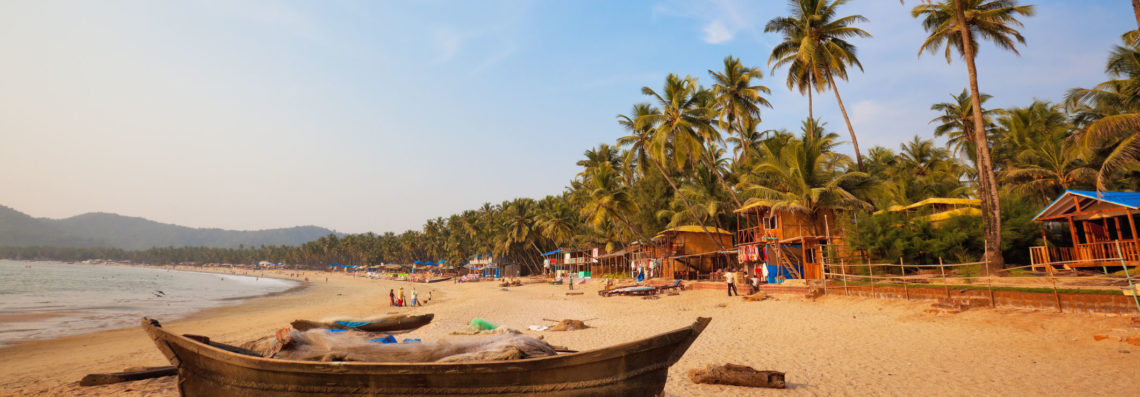The first credit card was introduced in India roughly 40 years ago. Yet, cards have failed to unlock financial access for the country’s poorest. That is why we are excited about the incredible growth of real-time payments that is taking place in India today. The adoption rate of its Unified Payments Interface (UPI) continued to increase sharply last year, driven by strong demand for online shopping. Normally, our team is behind the scenes, working with countries and companies to develop interoperable real-time payment systems like UPI. Here, however, Steve Haley, Mumbai-based Director of Economic Development, documents his firsthand experience with the impact that UPI, and specifically Google Pay, has had on merchants in rural India. Even this payments industry veteran was surprised by what he experienced.
I am a travel junkie and a staunch advocate of payment interoperability. That’s why I decided to do something a little different than the usual content on our site – a travel blog. Okay, so it’s not a real travel blog. Although, I will give you an amazing hotel recommendation in Goa if you find yourself in western India (keep reading for that). No, this 3-part blog series is my eye witness account of how UPI (India’s Unified Payments Interface) has dramatically impacted three locations that my wife and I visited on a six-week (socially distanced) road trip in India (with daily reminders of how privileged we were to do so). This first blog will cover our time in Agonda (Goa), while the subsequent blogs will describe our experience in Gokarna (Kanataka), and Mahabaleshwar (Maharashtra).
First, a little about me and why I chose to write about how I paid my hotel bills instead of how fluffy the towels were.
Why I’m an interoperable payments proponent
I lived in Italy, Egypt, and Myanmar during critical junctures as credit card payments gained traction in each of these countries. I’ve observed firsthand what “growth” looked like as this technology unfolded in each economy. In the first phase, credit card payments became available only at high-end tourist locations and hotels. Next, they were available at high-end restaurants. Later, it spread to high-end malls and supermarkets. See the trend? Lastly, after 5-7 years, credit cards were accepted in establishments that only catered to the local middle class. Then, tragically, the spread stopped before it reached the most vulnerable class of people – the ones who needed it the most.
I have also closely observed the rapid growth rate of person-to-person transactions in the mobile money industry. Yet, even today, I am still frustrated by the lack of interoperability which prevents the full utilization of this technology for merchant payments.
My (middle-class) payment bias
I speak a lot about inclusive payment systems in my work at ModusBox. I’ve come to realize that when most people hear the term “inclusive payments,” they often think first about the need to provide low-income customers with access to payment technologies. And, we tend to focus on how low-income shoppers can pay low-income merchants. Note that this is the opposite of the international card scheme’s success at giving middle-income customers the ability to pay middle-income merchants which I outlined above.
Combined with this polarized way of thinking, technology has enabled within us a bias towards merchants who provide convenient payment services. Personally, I have both a credit and debit card provided by a major US bank and a debit card through a major Indian bank. Yet, I still find myself thinking, why do I still have to use cash so #$&! often?
There is no “poor economy” or “wealthy economy.” There is one economy made up of all classes. And, because of this, the wealthy need to be able to pay the poor just as easily as the other scenarios.
About UPI and 3PPI/PISP
Through the development and advocacy of Mojaloop, our team (and the rest of the industry) often look to India’s UPI (Unified Payments Interface) as a leading example for interoperable real-time payment networks built on inclusive design principles. I won’t go into great depth on that subject here, but if you would like to know more about RTPs and UPI, Google put together an awesome intro here.
We’ve had the privilege of working with Google because they are a key partner bringing 3rd Party Payment Initiation (3PPI) service to Mojaloop. “What is 3PPI,” you ask? Initially, I did too. Essentially, 3PPI is the functionality that enables a Payment Initiation Service Provider to interact directly with the end-user, or account holder, to request the transfer of funds between two financial institutions connected via a real-time payment network. You can read more on the short blog we recently posted or check out this white paper we recently published with Google.
Real-time payments in real India
So, with my history in the payments industry, some preconceptions, and a self-diagnosed bias towards convenient payment methods, we set out on our road trip. My mission was to document how UPI, 3PPI in particular, and even-more-in particular, Google Pay, is enabling middle-income customers to pay low-income merchants – financial inclusion nirvana.
The experience blew my mind.
Agonda is located far from the airport. In a normal year, it hosts both Indian and foreign tourists. However, as COVID remains a concern, the only visitors to Agonda these days are upper-middle-class Mumbaikers like us who make the drive.
If you’ve ever been to North Goa, like Calangute, but have never headed to the south part of the state, you are really missing out. Pristine, quiet beaches with clean water. No parties. It’s idyllic unless you need more robust amenities (the upscale lodgings advertise hot showers). Traditionally, this has been a place to “disconnect.”
Luckily for WFH travel junkies, lack of connectivity is no longer a problem. We found excellent high-speed WiFi at all of the shacks and huts – except for our AirBnB. Of course! So, we headed out in search of a new place to stay for two weeks, settling into a mid-luxury shack located a quick 5-minute walk from the town’s sole ATM. This was fortunate because we discovered that the shack didn’t want to accept any of my three credit cards. Our luck ran dry, however, when we discovered that the ATM was out of cash and no one knew when it would be filled.
We returned to deliver the bad news to the receptionist at the check-in counter.
In the past, I’ve relied on a highly skilled persuasion tactic that would go something like this:
Me: The ATM is out of cash. Do you take Visa?
Shack: No.
Me: But I can see your Visa machine.
Shack: Not working.
Me: Please?
Shack: No.
Me: Pleeeeeeease?
Shack: Ok. Fine.
I was prepared for this exchange to commence as we conveyed our ATM misfortune to the receptionist at the check-in counter. That’s when we were asked the question that we would become accustomed to hearing throughout our time in Agonda.
“Do you have Google?”
I was stunned. Why, yes, we have Google. Everyone has Google. One could argue that Google has us, but that’s for another day. Thanks to the combination of UPI, 3rd party payment initiation functionality, and being cooped up indoors to escape a virus, middle-class Mumbaikers (like myself) have used GPay for home delivery of everything from food delivery to binge shopping this year. So, why hadn’t I thought of it? I brushed the thought aside for the moment.
The receptionist rattled off a phone number which I entered into my Google Pay app and presto! “Simrose Resort” popped up. I punched in the amount and my 4 digit UPI pin. Moments later we were settling into our room.

Crisis averted. But for how long? This was one of the nicest places in town (the recommendation I promised earlier). Logically, (remember those preconceived notions?) I determined that it was unlikely we’d be able to use our credit cards anywhere and our cash on hand wasn’t going to last us the full two weeks in Agonda. Fingers crossed that the ATM gods (i.e. those benevolent bankers) would refill the machine.
Last-ditch attempt to use a credit card

To avoid using our cash, we walked down the beach to The White, the nicest restaurant in town. If anyone in Agonda was going to take my credit card, it would be there. This was where we first noticed the bioluminescent light show as the waves crashed in Agonda. It’s also when I first realized how cool it is when you cross payment interoperability with Bigtech’s ability to acquire customers.
As we finished our meal on the patio, the waiter placed our bill under an AmazonPay QR stand. Completely unsolicited. That’s when the lightbulb really came on. GPay was going to be my go-to payment method during our stay. I scanned the QR code with my Google Pay app, entered my 4 digit UPI pin, and we headed to the water for a closer look at the green glowing plankton. However, before we even stood up from the table, the funds had cleared instantly from my bank account to the restaurant’s account. And, neither of us had revealed which bank we used. It was as magical as the scene before us!
Replacing cash right in front of our eyes
White was unfortunately the QR exception. At most restaurants, I had to go through a “tedious” (enter my privileged bias) 4-second process of entering in a phone number. However, unlike the Simrose Resort, this normally did not link to the name of the business. Instead, it was connected to the name of the cashier or the waiter. And, at the end of their shift, they would transfer all of the funds to a central till faster than you can say, “The era of real-time payments is upon us and even those of us in the industry can be caught off guard by how quickly it’s happening.”
I couldn’t believe it. They had replaced cash!
All in all, over the two weeks in Agonda, we only needed cash to pay for a break-of-dawn dolphin-watching boat trip and two shacks that hadn’t made the switch to India’s UPI. I asked every single establishment how long they had been accepting “Google” and the answer was always fewer than 6 months.
Only one place accepted credit cards. So much for my preconceived notions.
Stay tuned
Next up on our agenda, we headed further south to Gokarna which is outside of the foreign and Mumbai tourist circuit. From there, we traveled up to Mahabaleshwar in the hills with even fewer wealthy tourists. I doubted I’d find the same growth of UPI.
(Spoiler alert: my preconceptions would fail me once again)
Welcome to the era of RTP
The new regime is here. Credit cards and banks have had 40 years to reach Agonda. Real-time payments and third-party payment initiators in India only needed five. Issuing cards is cheap and easy. Acquiring small merchants is expensive and credit card providers have failed to do so. Today, real-time payments and 3PPI have changed the game.
That’s why we are excited to be partnered with Google to bring 3PPI to Mojaloop. Our goal is to help countries that lack India’s level of resources to achieve this scale of digitization. If you would like to learn more about Mojaloop or how we are driving financial inclusion in other countries, please contact our team today.







Great Story Steve